Clint Frazier finally cleared all the roadblocks. Eight years after being drafted fifth overall, the starting left field job was his. There were no more injuries or veterans blocking his path. More importantly, he had silenced the doubters by slashing .267/.394/.511 in 2020 with acceptable defense. The table was set for him to feast on the American League, but he’s barely touched his plate, slashing a meager .146/.293/.188. He’s struck out in nearly a third of his plate appearances and is still searching for his first home run.
The Yankees’ poor start isn’t entirely his fault, but his offensive shortcomings thus far epitomize their hitting woes. They’re 14th in the AL in runs scored and dead last in slugging percentage. It’s still very early, and over the course of the full season, neither the team nor Frazier himself will remain this downtrodden. Something has to give, though. What does he have to do to regain his 2020-level productivity?
Swinging at strikes
The most oversimplified explanation of hitting philosophy is, “Swing at good pitches and don’t swing at bad ones.” Easier said than done when you’re facing Shane Bieber, but the premise holds true.
Lately, Frazier has trouble discerning the good ones from the bad, particularly on the outer half of the plate. He has seen 64 pitches on the outer half of the strike zone, only swinging at 25 of them at whiffing on eight. Statcast generates a swing/take profile for each hitter, and he has spat on strikes at an alarming rate. He has only swung at 60 percent of pitches in the heart of the strike zone and 39 percent on the shadow, both of which are 13 percentage points below league average.
Watching strikes go by is acceptable early in the count if the batter doesn’t like the pitch, but it’s much less palatable with two strikes. Frazier has failed to offer at two-strike pitches in the heart of the strike zone five times this year, second only to Robbie Grossman’s six. Ten times this year he has struck out looking, tied for third-most in MLB. For example, here’s a 3-2 fastball right down the chute for called strike three on April 22 (video from Baseball Savant):
Overall, he’s been more passive at the plate than just about any hitter in MLB. His total swing percentage is 34.2. Only Yasmani Grandal and Max Muncy swing less often among all players with 50 plate appearances. At face value, he’s keeping pretty good company, but Grandal and Muncy both make more contact when they decide to pull the trigger. Their swinging strike rates are 6.2 and 7.4 percent, whereas Frazier’s is 10.9. His contact rate of 68.1 percent is also ten points lower than theirs.
The one positive note about his hitting has been a career-best 16.1 percent walk rate. That’s the silver lining of his extreme passivity at the dish. If he would offer at more pitches in the strike zone, especially with two strikes, the resulting production would certainly be worth losing a few walks.
Indefensible defense
In 2019, Frazier’s defensive lapses got him sent down to the minors. He’s an above-average runner who came up as a center fielder, but a series of mistakes contributed to -6 defensive runs saved (DRS). In 2020, he completely redeemed himself with 4 DRS, becoming a Gold Glove finalist. Unfortunately, his 2021 defense has reverted back to 2019 levels.
Defensive stats are notoriously fickle and should be taken with several grains of salt, especially early in the year. However, he’s just 2nd percentile in outs above average and 1st percentile in outfielder jump according to Statcast. Here’s a ball he let drop inexcusably (courtesy of Baseball Savant):
Frazier has been a part of the starting lineup for seven Yankee wins this year. In five of them, Aaron Boone has substituted him out in the late innings for a better defender such as Brett Gardner or Mike Tauchman. Based on his superb outfield play last season, that shouldn’t be necessary. In 2020, he caught 93 percent of balls hit his way— three points better than his expected catch rate based on Statcast metrics. This year, it’s only 76 percent, with an expected catch rate of 87 percent. His -4.6 feet vs. average outfielder jump is more than a foot worse than any other outfielder in MLB.
After entering Sunday’s game as a substitute, he made his absolute greatest catch of the season so far. Frazier is too good to be this bad— offensively and defensively. All players go through slumps for one reason or another. When this happens at the beginning of the season, it gets magnified because of the ugliness of the player’s batting line. It’s still April and he only has 56 plate appearances all year. He deserves enough benefit of the doubt to let him turn things around, but swinging the bat a little more often and getting better reads on fly balls would be a good place for him to start.




